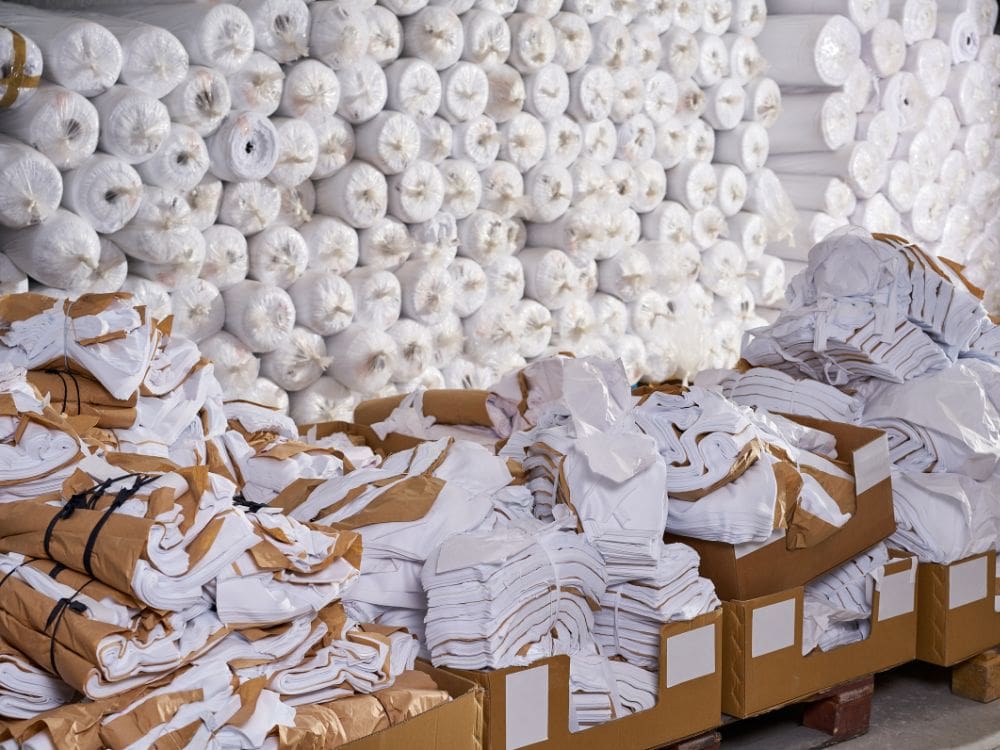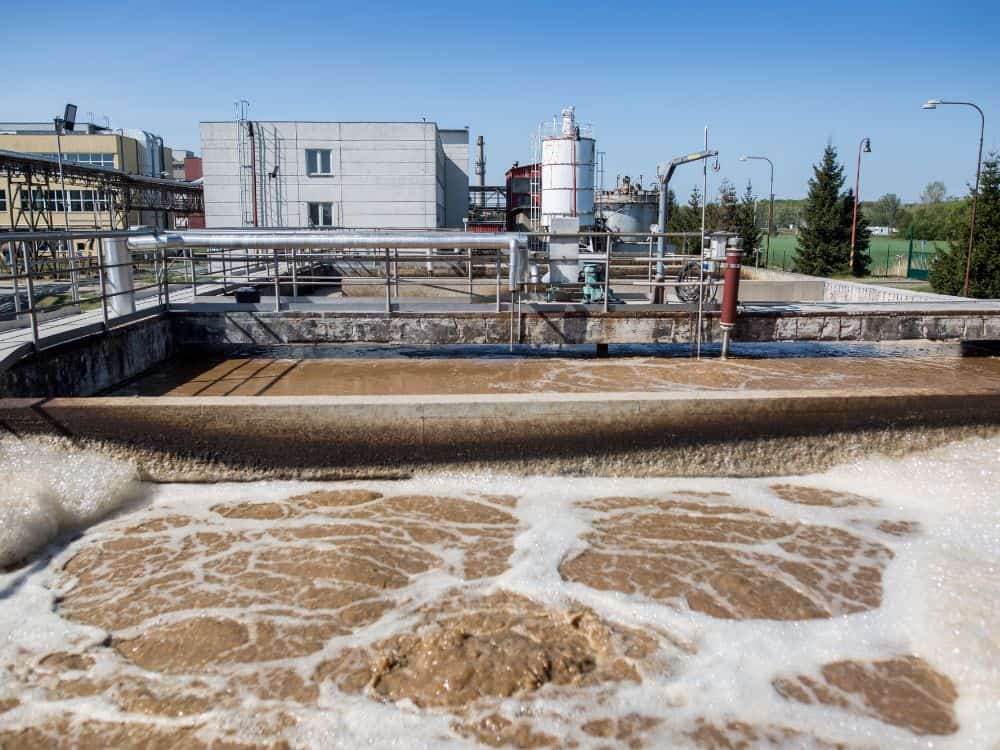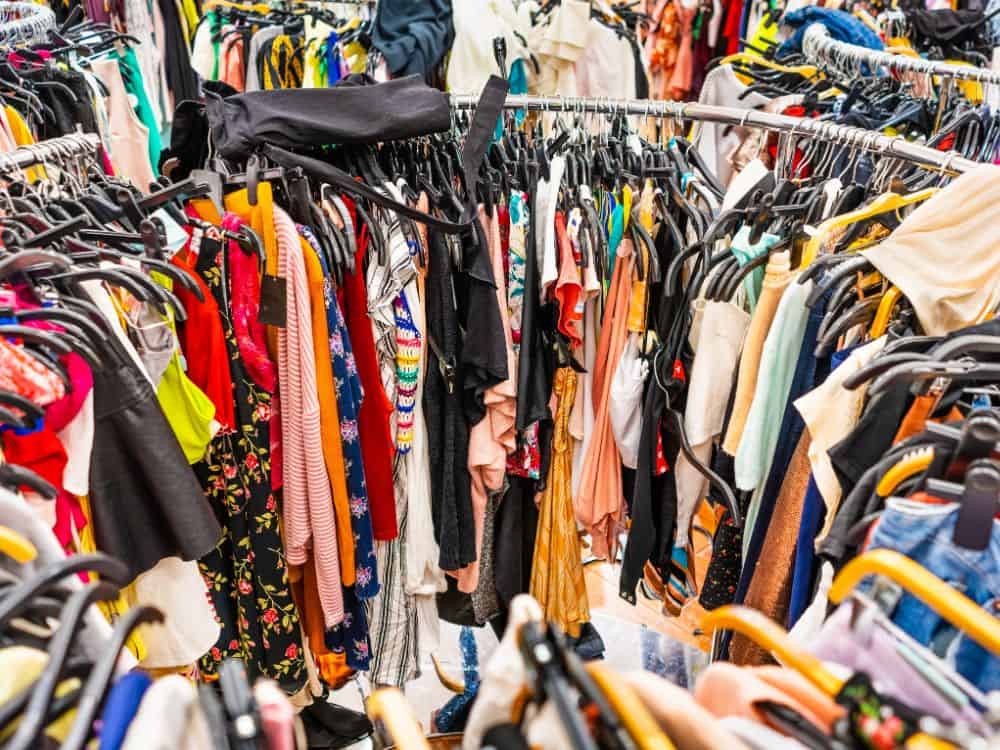Fast fashion as an industry is a fast lane to ecological obliteration and total erosion of human rights and you don’t need a masters in sustainability to understand fast fashion facts. As sustainability professional Livia Firth puts it, “Fast fashion is like fast food. After the sugar rush, it just leaves a bad taste in your mouth.”
From synthetic fabrics made from non-renewable fossil fuels and fashion’s ocean plastics crisis, to an industry-wide disregard of ethical sourcing and ongoing pervasive labor crimes against humanity, fast fashion facts and statistics paint a dystopian picture of our planet that we’re heart-set on reshaping.
When Rana Plaza happened a decade ago, the average fast fashion retailer sold around 500 designs per week. Today the average fast fashion retailer sells around 6,000 new designs PER DAY.
You read that right. And as fast fashion growth statistics skyrocket, so do the truly horrifying facts.
But clothes are here to stay. They’re a means of self-expression, after all—both very good things, when a happy future of humanity and our Earth are at the core of our closets. So let’s unbutton our way through some tough truths and spit some fast fashion statistics that will hopefully convince you (if you’re not already) that the global fashion agenda is LONG in desperate need of systemic change from head-to-toe.
Contents: Fast Fashion Industry Statistics
- 150 Billion Garments Are Produced Annually Jump to section
- The Average American Tosses Over 81 Lbs Of Clothing Yearly Jump to section
- Fast Fashion Production, Industrial Water Use, And The Planet’s Wastewater Jump to section
- 35% Of All Ocean Microplastics Derive From Synthetic Textiles Jump to section
- Two-Thirds Of Fast Fashion Textiles Are Made With Petroleum Jump to section
- 300 Million Trees Are Logged Annually For Fashion Jump to section
- 2.6 Million Tons Of Returned Clothes In US Landfills Jump to section
- Fast Fashion Is So Cheap, Even Brands Don't Want Returns Back Jump to section
- 93% Of All Labels Do Not Pay Garment Workers A Living Wage Jump to section
- 160 Million Children Are Fashion Industry Child Laborers Jump to section
- Fast Fashion Brands Like Shein Score Less Than 10% On The Fashion Transparency Index Jump to section
150 Billion Garments Are Produced Annually
The sheer volume is one of the most eye-opening facts about the fast fashion industry.
Every single year, nearly 150 billion items of apparel are produced by the industry—enough to supply every person on Earth with more than 14 new pieces of clothing each year. Automotive and technology industries are the only two larger than production for the textile and apparel sectors. We’re also already making double the amount of clothes produced in 2000.
Meanwhile, within the first year of purchase, more than 60% of these garments are discarded.
For a human population of around 8 billion people, 150 billion annual apparel items is a staggering amount of clothes, especially when you consider the global greenhouse gas emissions paired with the uneven distribution of the items. Most things tend to be made in the global south, and consumed by only a small handful of countries in our global north.
Adding to the problem is that clothing production doesn’t even mean it gets sold or used. Many fast fashion clothes end up as deadstock in overflowing landfills, where we continue to add to these alarming figures by piling billions more clothing items year upon year, which end up festering in landfills for centuries, if not millennia.
The Average American Tosses Over 81 Lbs Of Clothing Yearly
Items fly off the shelves… right into the dumpster. Fast fashion waste facts are perhaps the most staggering.
In America alone in 2018, 11.3 million tons of textile waste, which equates to 85% of all textiles produced, found their way to the landfill or incinerator. That’s around 82 lbs (37 kgs) per American per year, or 2,150 pieces discarded every single second nationwide.
The equivalent of a full truck load of clothing is taken to the landfill every second of every minute—of every day of every year—thanks to excessive global apparel consumption and production.
And that’s just at our current rate of consumption, which had already doubled in the last two decades. Today, one in three young women thinks a garment is “old” after being worn once. If fast fashion trends continue to trend upward, so, too, will fast fashion pollution statistics.
Fast Fashion Production, Industrial Water Use, And The Planet’s Wastewater
Waste is one terrible thing, but it’s a small, distracting fraction of fast fashion’s overall impact.
For perspective on fashion’s massive water problem, to produce a single kilogram of cotton takes 10,000 liters of water. A single cotton t-shirt—unless we’re talking about organic cotton t-shirts—requires around 3,000 liters of water allocated to cotton production.
To add to this, the textile industry’s dyeing predominantly uses toxic chemicals that end up in our waterways and oceans. Around 20% of the world’s wastewater is attributed to this process, which only accumulates and worsens over time.
To add to the dilemma, many overseas factories are opened in developing countries without environmental regulation enforcement. Much of the wastewater is highly toxic and in many cases, cannot be treated to become usable again.
35% Of All Ocean Microplastics Derive From Synthetic Textiles
That’s right—35%!
To add to the water crisis, fast fashion environment facts are that the industry also contributes significantly to the mounting microplastic catastrophe. In fact, things have gotten so bad that fortunately there is a Global Plastics Treaty in the works.
Fast fashion is built upon cheap, synthetic fabrics like polyester and nylon that shed microplastic particles when they’re washed, finding their way through our waterways to pollute our oceans.
It’s estimated that each time we do our laundry, almost 10 million microfibers are released that wastewater treatment plants cannot filter out. The sum total of this, according to the World Economic Forum, is that half a million tons of microplastics are dumped into the ocean every year, which is equal to 50 billion plastic bottles.
If that alone doesn’t concern you, maybe the fact that these microplastics are now working their way through the food chain and into human bodies will.
Two-Thirds Of Fast Fashion Textiles Are Made With Petroleum
Microplastics are (obviously) plastic, and where does most plastic come from? Usually petroleum.
In fact, 69% of all fast fashion clothes are derived from fossil fuels. This figure is expected to skyrocket to more than three quarters by 2030, when 85% of all fast fashion fabrics will be polyester.
Not only is this problematic given that petroleum is a non-renewable energy resource mired in corruption, wars, economic greed, environmental destruction, and climate change, but it’s also incredibly energy-intensive to turn oil and gas into textiles, plus the aforementioned global waste, global pollution, and global microplastic crises.
Then there’s one of the most shocking fast fashion facts today: fashion’s fuel for new clothing helps “fuel” the Russia-Ukraine war, due to European and North American demand for oil for polyester textile production. Brands that are directly and indirectly buying synthetic fabrics mired in the Russia-Ukraine war include a combination of streetwear and fast fashion brands, such as Adidas, Asics, Boohoo, Gap, Hugo Boss, Inditex, Levi’s, Nike, The North Face, and Uniqlo.
300 Million Trees Are Logged Annually For Fashion
Statistics indicate fast fashion has a massive deforestation problem, too. More than 300 million trees are logged yearly (and not all from sources with sustainable forestry certifications) to manufacture cellulose-based fabrics like viscose, or to clear pastures for grazing cattle who are later slaughtered for their leather skins. To imagine this number, if all the trees were placed end-to-end they would circle the planet SEVEN times.
Currently, richly diverse Indonesian jungles, Canada’s Boreal forest, and the Brazilian Amazon Rainforest are being clear-cut for the latest season’s fashions.
Yet our demand for wood pulp is only growing, with production projected at 15 million tons higher in 2035 than 2018.
Sadly, many fashion industry leaders have little clue that their fashionable creations are being made at the cost of the world’s most integral ecosystems. So while man-made cellulosic fibers (MMCF) made from wood pulp tend to be considered more sustainable than plastic-based fibers like acrylic or polyester, they’re doing more harm than we think.
You may have ditched paper disposables in favor of things like reusable paper towels, but unless we’re willing to do the same for our wardrobes, wanton war on our planet’s most crucial carbon sequestering entities isn’t going to stop.
2.6 Million Tons Of Returned Clothes In US Landfills
Fast fashion waste statistics indicate that returned clothes are also a huge problem. Worldwide, 9.5 billion pounds of returned garments are landfilled yearly, with the US responsible for 2.6 million tons.
In other words, when you buy something, decide you don’t like it or it doesn’t fit, and return it, it’s likely that the garment ends up at the dump. That’s because it usually costs more for the retailer to put the item back in circulation than to just get rid of it.
Then there are the environmental costs of online shopping returns. Reverse logistics company Optoro estimates that in 2020, online returns in the US were responsible for 16 million tons of CO2 emissions—or the global carbon emissions’ equivalent of 3.5 million cars on the road for an entire year.
Fast Fashion Is So Cheap, Even Brands Don't Want Returns Back
On the flipside to the issue of clothing returns is the issue of no returns for mistakes or damaged purchases. Ultra-fast fashion giants like Shein, Romwe, or Fashion Nova make pocket-change clothing so cheap that it’s usually more economical to refund the item than having it returned to them.
Because Shein’s return policy often allows buyers to just keep the clothes for free, TRAID, a UK charity working to stop clothes from being thrown away, has seen a dramatic increase in brand new, cheap, unworn, and already busted items, making the charity’s plight to reduce the truckload of clothes per second to the landfill a seriously daunting one.
Meanwhile, the volume of daily item “drops” has become staggering beyond words, with Shein fast fashion statistics indicating the brand launches 6,000 styles per day. (For context, fast fashion brand Zara releases about 20,000 per year).
And only 1% of that ever gets recycled.
93% Of All Labels Do Not Pay Garment Workers A Living Wage
Ethical supply chains and workers rights remain an issue, despite industry promises post-Rana Plaza collapse ten years ago, with less than 10% of brands paying garment workers at least minimum wage.
This is simply unacceptable, but since so many fast fashion brands’ factories are located in countries with emerging markets and loose rules, workers toil for exhausting hours, with payment far from fair.
Fashion Checker is a program by the Clean Clothes Campaign, funded by the European Union, helping to track which industry players pay their workers a living wage. Of the 311 brands surveyed, the campaign found that 93% of the fashion industry is responsible for paying garment workers unfairly.
According to Good On You, the fashion industry’s most comprehensive and rigorous rating system, 86% of the world’s fast fashion brands either don’t disclose anything regarding living wages or do not pay living wages at any stage of the supply chain.
160 Million Children Are Fashion Industry Child Laborers
If any of the bad facts about fast fashion make us want to run away to a nudist colony, it’s this one.
And alongside 160 million child laborers, sweatshop labor and forced labor also remain a human rights disaster, with nearly 28 million people in forced labor and sweatshops operating in at least 150 countries worldwide. In the 1990s, sweatshop accusations nearly destroyed Nike, and now we even have laws against modern slavery.
Why is that thirty years later, the problem has only grown worse?
It comes down to the toxic interplay of ignored ethics for the sake of economics. As the rich get richer, the poor continue to get poorer, which leaves hungry and vulnerable families thinking they have no choice but to send their kids to work in factories.
The fashion and textile industry is as much built on the backs of children as it is modern slavery—Shein, for example, is right now under intense scrutiny for its cotton from the Xinjiang region, where Uyghur peoples are forced to harvest it.
Fast Fashion Brands Like Shein Score Less Than 10% On The Fashion Transparency Index
Statistics about fast fashion ironically clearly highlight the industry’s dubious transparency issue.
Fashion Revolution surveys the largest fashion retailers every year to track the accountability of fashion brands, their supply chains, and their social and environmental policies. The report, called the Fashion Transparency Index, evaluates 250 brands on their transparency, since it’s the only way to foster accountability and incentivize increased communication and efforts to do better.
Their most recent fast fashion statistics found that “99% of major brands and retailers do not publish the number of workers in their supply chains paid a living wage”.
A paltry 27% of brands even provide a plan for providing better wages along their supply chain.
Transparency is probably the single most difficult impediment to environmental and ethical change in the disastrous industry. When brands refuse to be transparent about their operations, it’s impossible for real accountability and thus real industry change.


















